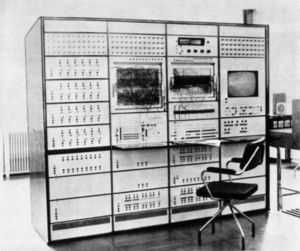Hybrid computer

Hybrid computers are computers that exhibit features of analog computers and digital computers. The digital component normally serves as the controller and provides logical operations, while the analog component normally serves as a solver of differential equations. The HRS-100 was a prominent example in the 1970s. Late in the 20th century, hybrids dwindled with the increasing capabilities of digital computers including digital signal processors.[1]
In general, analog computers are extraordinarily fast, since they can solve most complex equations at the rate at which a signal traverses the circuit, which is generally an appreciable fraction of the speed of light. On the other hand, the precision of analog computers is not good; they are limited to three, or at most, four digits of precision.
Digital computers can be built to take the solution of equations to almost unlimited precision, but quite slowly compared to analog computers. Generally, complex equations are approximated using iterative numerical methods which take huge numbers of iterations, depending on how good the initial "guess" at the final value is and how much precision is desired. (This initial guess is known as the numerical seed for the iterative process.) For many real-time operations, the speed of such digital calculations is too slow to be of much use (e.g., for very high frequency phased array radars or for weather calculations), but the precision of an analog computer is insufficient.
Hybrid computers can be used to obtain a very good but relatively imprecise 'seed' value, using an analog computer front-end, which is then fed into a digital computer iterative process to achieve the final desired degree of precision. With a three or four digit, highly accurate numerical seed, the total digital computation time necessary to reach the desired precision is dramatically reduced, since many fewer iterations are required. One of the main technical problems to be overcome in hybrid computers is minimizing digital-computer noise in analog computing elements and ground systems.![]() No comment with respect to IP address(es)
No comment with respect to IP address(es)
Consider that the nervous system in animals is a form of hybrid computer. Signals pass across the synapses from one nerve cell to the next as discrete (digital) packets of chemicals, which are then summed within the nerve cell in an analog fashion by building an electro-chemical potential until its threshold is reached, whereupon it discharges and sends out a series of digital packets to the next nerve cell. The advantages are at least threefold: noise within the system is minimized (and tends not to be additive), no common grounding system is required, and there is minimal degradation of the signal even if there are substantial differences in activity of the cells along a path (only the signal delays tend to vary). The individual nerve cells are analogous to analog computers; the synapses are analogous to digital computers.
Hybrid computers should be distinguished from hybrid systems. The latter may be no more than a digital computer equipped with an analog-to-digital converter at the input and/or a digital-to-analog converter at the output, to convert analog signals for ordinary digital signal processing, and conversely, e.g., for driving physical control systems, such as servomechanisms.
External links
- A New Tool For Science By Daniel Greco and Ken Kuehl, The Wisconsin Engineer, Nov 1972, reprinted Feb 2001
- Nadel LD, Kramer MR, Shultheis DC, McCulloh TA (April 1977). "A hybrid computer system for use in cardiology". Med Prog Technol 4 (4): 185–91. PMID 865418. "Recent upsurge in the use of physiologic data for medical diagnostic and treatment procedures has prompted the medical profession to use the computer to automate and reduce the time required for data processing. Although the digital computer has traditionally been used to perform these tasks, a hybrid computer (combined analog and digital) has been found to provide many advantages over the digital computer, especially where on-line data processing is concerned. As a result, the Bio-Medical Engineering Center has installed a centrally located hybrid computer system at Ohio State University. One of the applications of this system has been processing cardiac catheterization data. Data is transmitted between the hospital and computer via infrared optics. The data can be analyzed in real time, with the results immediately available to the physician."
References
- ↑ The Analogue Alternative, the Electronic Analog Computer in Britain and the USA, 1930-1975, by James S Small